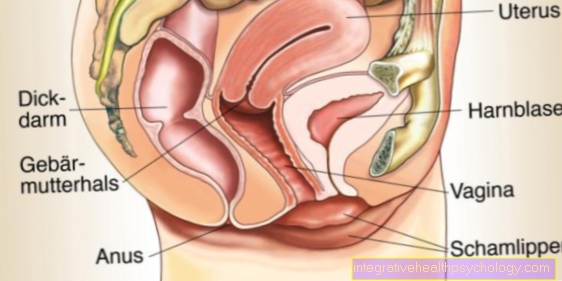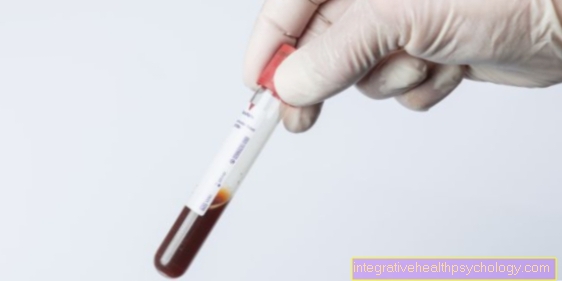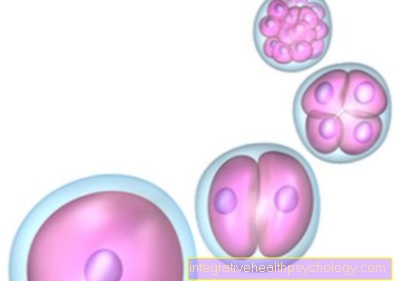When does low blood pressure become dangerous?
introduction
Blood pressure values below 105/60 mmHg are referred to as blood pressure that is too low. However, it is not possible to say in general when low blood pressure becomes critical for the person concerned.
It is even assumed that rather low blood pressure values have a protective effect on the vessel walls.
If the low blood pressure becomes symptomatic in an affected person, this is a clinical picture that should be treated. However, the blood pressure from which treatment is indicated is controversial. In the case of blood pressure values below 90/60 mmHg, some doctors assume that treatment is indicated.

Symptoms of low blood pressure
Typical symptoms of hypotension (low blood pressure) are specific general disorders. These are very typical, which is why they can usually be clearly assigned to a hypotonic state. These include dizziness or visual disturbances (typically staring or turning black in front of the eyes). These two sensory disorders go back to a lack of blood supply to the cerebral vessels with a consequent lack of oxygen.
This undersupply of blood occurs mainly in the morning or when changing positions (typically from lying to standing). In general, daily fatigue and poor performance are common. With regard to the intellectual ability at work, etc., there is often a strong restriction in the ability to concentrate. Since the body tries to centralize the blood volume to the vital organs of the heart and brain in hypotension, the fingers and toes can feel cold and the patient becomes generally pale. The development of circulatory disorders can lead to a circulatory collapse with consecutive syncope (unconsciousness). An increased need for sleep is also typical in connection with severe fatigue. Those affected often complain of sweating and the occurrence of palpitations, ringing in the ears or a rapid pulse.
All of these phenomena can be traced back to an attempt to compensate for the heart, which tries to compensate for the low blood pressure by increasing the heart rate and the stroke volume.
Read more on the subject at: Symptoms of low blood pressure, low blood pressure and headache, or low blood pressure and low pulse
Short-term consequences of low blood pressure
In the short term, low blood pressure (hypotension) can lead to an imbalance of the circulatory system. Especially in young women with a slim build, syncope (unconsciousness) lasting several seconds is more common, but this is usually reversible. These are announced primarily by warning signs such as dizziness and blackening in front of the eyes. This syncope can be dangerous if you fall.
Read more on the topic at: Low blood pressure and dizziness
Long-term consequences of low blood pressure
If blood pressure values (hypotension) are moderately decreased and do not cause specific symptoms (especially syncope), they should usually not be considered in need of treatment. On the contrary, there is no evidence that low blood pressure values cause any specific damage to the cardiovascular system in the long term. Rather, hypotension has protective effects on the vascular system.
However, if the symptoms mentioned above occur, the hypotension should be treated therapeutically. It is important to prevent possible complications such as falls or a permanent decline in performance at work, etc. In the long term, if the blood pressure is low, caused by a lack of volume, a possible reduction in blood flow to the kidneys can be classified as critical. As with renal artery stenosis, there is a decrease in the glomerular filtration rate (GFR). Renal insufficiency, for example, can develop over time.
According to several reports, hypotension and the associated reduced blood supply to the brain increases the risk of stroke.
Long-term consequences can also arise, for example, if recurrent falls occur in the context of hypotension. Especially in older people (e.g. femoral neck fractures) or pregnant women (e.g. traumatic injury to the fetus) these can lead to serious long-term complications.
You might also be interested in our next article: Low blood pressure and high pulse
Can there be a serious illness behind low blood pressure?
Low blood pressure (hypotension) can be a serious illness. Organic disease in particular should be ruled out as a cause of hypotension. For example, certain cardiac arrhythmias (including atrial fibrillation, reentry tachycardia, etc.) are accompanied by hypotension. You should be treated promptly with antiarrhythmic drugs.
An underactive thyroid, especially in the form of Hashimoto's thyroiditis, can also be associated with hypotension. This is an autoimmune-mediated disease. The risk of other autoimmune diseases is increased (for example type 1 diabetes mellitus).
It is important to follow up with a diagnosis of the cause of a newly developed hypotension with accompanying symptoms. A clinical examination should be supplemented by an ultrasound examination of the heart (echocardiography). In this way, organic causes of hypotension can be excluded. An echocardiographic examination, for example, would reveal signs of a heart rhythm disorder or heart failure (heart failure).
The following topic could also be of interest to you: What to do with low blood pressure, causes of low blood pressure
When is low blood pressure dangerous during surgery?
During many surgical interventions, the aim is to lower the blood pressure values to a certain extent in order to prevent possible complications such as intraoperative bleeding. On the other hand, too low blood pressure during an operation is viewed as critical. Studies have shown that blood pressure that is too low before the operation actually increases postoperative mortality, while high blood pressure reduces it.
The anesthetics used have a regulating effect on the blood vessels by expanding them (vasodilation). As a result, blood pressure drops. This has little effect on healthy patients. However, in patients with pre-existing cardiovascular diseases or a lack of fluids, anesthesia can have serious effects on blood pressure. If the anesthetist notices a critical drop in blood pressure (for example, due to a reflex increase in heart rate), countermeasures are initiated. These include the administration of sympathomimetics (for example noradrenaline, cafedrine-theodrenaline in the form of Akrinor® or ephedrine) or volume administration in the form of infusions to balance the fluid balance.





























